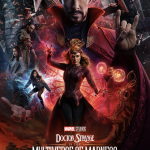In 1961, Kempton Bunton, a 60 year old taxi driver, steals Goya’s portrait of the Duke of Wellington from the National Gallery in London.
Chuck says:
In 1961, the British government arranged to buy Goya’s portrait of the Duke of Wellington for 140,000 pounds, an extravagant expenditure that sparked a bit of controversy as the argument was made that these funds could be better used to help the country’s unemployed. After much fanfare, on August 19, 1961, it was put on display at London’s National Gallery.
It was stolen 19 days later.
Roger Michell’s “The Duke,” is a character study of Kempton Bunton, the bus driver who confessed to stealing the painting, returning it and confessing to the crime in 1965. As written by Richard Bean and Clive Coleman, the movie compresses the timeline, the events as portrayed here occurring over four or five months. No matter. The film has charm to spare, much of that provided by screen veteran Jim Broadbent who’s able to portray Bunton, an eccentric with a heart of gold, without making him look like a fool.
This is quite a feat as this would-be author/rabble-rouser lives for making grand gestures and seeking the approval of others, often to his own determent and that of his long-suffering wife Dorothy (Helen Mirren). He longs to be a writer – his magnum opus, “The Adventures of Susan Christ” imagines Jesus as a woman – and while he writes from the heart, his lack of talent insures he’ll never get far. There seemingly wasn’t a lost cause Bunton wouldn’t take up or anyone he wouldn’t defend if he thought it justified. The result was many minor brushes with the law and being looked at as a bit of a crackpot.
Still and all, he remains optimistic about the world and his place in it, views that are expressed with a sense of naïve conviction at his trail, one of the many subtle highlights of the movie. It’s remarkable that he’s able to maintain such a rosy outlook as we find that he and Dorothy have had their share of tragedy to contend with and their sons haven’t exactly set the world on fire.
It goes without saying that Broadbent and Mirren are among our finest film actors and watching them play off one another is a delight. If the film has a fault, it’s that they don’t share more scenes together as Bunton is the focus. However, Mirren makes the most of her moments, sincere in her portrayal of this damaged woman who eventually finds a sense of peace amidst the constant turmoil her husband creates. Her performance is a masterful example of subtlety and grace.
I couldn’t help but recall Frank Capra’s “Mr. Deeds Goes to Town” as I watched Bunton employ folksy wisdom and simple common sense to explain is motives and provide a sense of perspective that the cynical eagerly scoff at and those in power often dismiss. The trial puts this simple man in the spotlight and Broadbent is wise to not focus on his character’s outlandishness but his sincerity, something the actor expertly realizes.
Much like the film’s protagonist, there’s more here than meets the eye. There’s a third-act twist that seems so outlandish, it initially doesn’t seem to be true. That it turns out to be so, adds another dimension to all we’ve seen, the story suddenly becoming more than its tone belies. The events in “The Duke” extended far beyond Bunton’s act and trial – make sure to sit through the credits – but what we’re left with is a reminder that dreamers like Bunton should be cherished not shunned. We’d all be better off following their lead where applying common sense solutions to help those in need are concerned.
3 1/2 Stars




